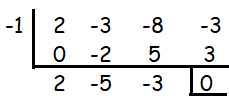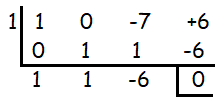ROOTS OF CUBIC EQUATION
Subscribe to our ▶️ YouTube channel 🔴 for the latest videos, updates, and tips.
Let ax3 + bx2 + cx + d = 0 be any cubic equation and α, β and γ be the roots.
α + β + γ = -b/a
αβ + βγ + γ α = c/a
αβγ = -d/a
Example 1 :
Solve the following cubic equation whose roots are in arithmetic progression.
x3 - 12x2 + 39 x - 28 = 0
Solution :
When we solve cubic equation we will get three roots.
Since the roots are in arithmetic progression, the roots can be taken as given below.
p - q, p, p + q
Compare :
x3 - 12x2 + 39x - 28 = 0 and ax3 + bx2 + cx + d = 0
a = 1, b = -12, c = 39, d = -28
Sum of the roots = -b/a
p - q + p + p + q = -(-12)/1
3p = 12
p = 4

4 is one of the roots. The other roots can be determined by solving the quadratic equation
x2 - 8x + 7 = 0
x2 - 8x + 7 = 0
(x - 1)(x - 7) = 0
x - 1 = 0 or x - 7 = 0
x = 1 or x = 7
Therefore the roots are 1, 4 and 7.
Example 2 :
Solve the following cubic equation whose roots are in geometric progression.
x3 - 19x2 + 114x - 216 = 0
Solution :
When we solve cubic equation we will get three roots.
Since the roots are in geometric progression, the roots can be taken as given below.
p/q, p, pq
Compare :
x3 - 19x2 + 114x - 216 = 0 and ax3 + bx2 + cx + d = 0
a = 1, b = -19, c = 114, d = -216
Product of roots = -d/a
p/q ⋅ p ⋅ pq = -(-216)/1
p3 = 216
p3 = 63
p = 6

6 is one of the roots. The other roots can be determined by solving the quadratic equation
x2 - 13x + 36 = 0
(x - 4)(x - 9) = 0
x - 4 = 0 or x - 9 = 0
x = 4 or x = 9
Therefore the roots are 4, 6 and 9.
Example 3 :
Solve for x : 2x3 – 3x2 – 8x – 3 = 0
Solution :
Let p(x) = 2x3 – 3x2 – 8x – 3
When x = -1
p(-1) = 2(-1)3 – 3(-1)2 – 8(-1) – 3
= -2 - 3 + 8 - 3
= -8 + 8
= 0
So, -1 is one of the roots of the cubic equation.

2x2 - 5x - 3 = 0
2x2 - 6x + 1x - 3 = 0
2x(x - 3) + 1(x - 3) = 0
(2x + 1)(x - 3) = 0
2x + 1 = 0 and x - 3 = 0
2x = -1 and x = 3
x = -1/2 and x = 3
So, the solutions are -1, -1/2 and 3.
Example 4 :
Solve for x : 2x3 – x2 – x = 0
Solution :
Let p(x) = 2x3 – x2 – x
Factoring x, we get
= x(2x2 – x – 1)
Since p(x) = 0
x(2x2 – x – 1) = 0
x = 0 and 2x2 – x – 1 = 0
2x2 – 2x + 1x – 1 = 0
2x(x - 1) + 1(x - 1) = 0
(2x + 1) (x - 1) = 0
2x + 1 = 0 and x - 1 = 0
2x = -1 and x = 1
x = -1/2 and x = 1
So, the solutions are x = -1/2, 0 and 1.
Example 5 :
Solve for x : x3 – x = 0
Solution :
Let p(x) = x3 – x = 0
Factoring x, we get
= x(x2 – 1)
Since p(x) = 0
x(x2 – 1) = 0
x = 0 and x2 – 1 = 0
x2 = 1
x = -1 and 1
So, the solutions are 0, -1 and 1.
Example 6 :
Solve for x : (2/3)x3 – 18 = 0
Solution :
Let p(x) = (2/3)x3 – 18 = 0
(2/3)x3 = 18
x3 = 18 (3/2)
x3 = 9 (3)
x3 = 27
x3 = 33
x = 3
So, the value of x is 3, we have repeating roots.
Example 7 :
The roots of the cubic equations x3 - 7x + 6 = 0 are
a) 1, 2 and 3 b) 1, -2 and 3
c) 1, 2 and -3 d) 1, -2 and -3
Solution :
Using synthetic division, let us check if the cubic polynomial has the root 1.

While dividing the polynomial by 1, we get 0 as remainder, then 1 is one of the roots of the polynomial.
x2 + x - 6 = 0
x2 + 3x - 2x - 6 = 0
x(x + 3) - 2(x + 3) = 0
(x - 2)(x + 3) = 0
x - 2 = 0 and x + 3 = 0
x = 2 and x = -3
So, the solutions are -3, 1 and 2.
Example 8 :
The roots of the cubic equations x3 + 9x2 - x - 9 = 0 are
a) 1, 2 and 3 b) 1, -1 and -9
c) 1, 3 and -9 d) 1, 3 and 9
Solution :
Using the method of factoring, we get
x3 + 9x2 - x - 9 = 0
x2(x + 9) - 1(x + 9) = 0
(x2 - 1)(x + 9) = 0
x2 - 1 = 0
x2 = 1 and x + 9 = 0
x = -1, 1 and -9
So, the solutions are -1, 1 and -9, option b is correct.
Subscribe to our ▶️ YouTube channel 🔴 for the latest videos, updates, and tips.
Kindly mail your feedback to v4formath@gmail.com
We always appreciate your feedback.
About Us | Contact Us | Privacy Policy
©All rights reserved. onlinemath4all.com

Recent Articles
-
10 Hard SAT Math Questions (Part - 40)
Dec 25, 25 08:30 AM
10 Hard SAT Math Questions (Part - 40) -
10 Hard SAT Math Questions (Part - 41)
Dec 24, 25 07:58 PM
10 Hard SAT Math Questions (Part - 41) -
ASTC Formula in Trigonometry
Dec 23, 25 11:34 PM
ASTC Formula in Trigonometry - Concepts - Examples and Solved Problems


